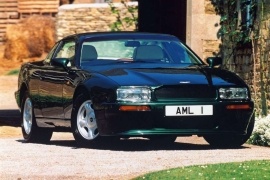ASTON MARTIN Virage Models/Series Timeline, Specifications & Photos
First production year: 1988
Engines: Gasoline
Body style: Coupé (two-door)
Aston Martin chose the 2011 Geneva Motor Show to unveil its latest creation, the Aston Martin Virage. It was a true GT and placed between the DB9 and the DBS.
While the GT-segment started to be crowded by more brands, the Aston Martin tried to offer more refinement to get more attention. Despite that effort, the Virage was built only in two years, in both versions as a coupe or convertible. It was the only Aston Martin offered exclusively with an automatic gearbox and a V12 engine of that time.
The front grille was inspired by the One-77 model and the fluid lines of the bodywork were shaped in a unique way for the GT market. Unlike the Bentley Continental GT or the Mercedes-Benz S-Class Coupe, the Aston Martin looked more appropriate in the company of a Ferrari. The long headlights with the LED for daytime running lights included, the wide air-intakes with a mesh on the front apron were part of the emotional, Aston Martin, design language. In the back, the horizontal placed V-look taillights were unique on the market.
Inside, the luxurious interior featured a dashboard covered in leather, a four-dials instrument cluster, and paddle shifters behind the steering wheel. The center stack featured the controls for the climate control unit and the audio system. On top of that, covered by a lid, was the navigation system.
The Aston Martin Virage was offered with a V12 engine and a 6-speed automatic gearbox with a manual mode for shifting gears. A limited-slip differential was standard and so were the carboceramic brake-discs.
The 1988 Virage was another fine example of a heavy Grand Tourer car built by Aston Martin and marked the end of an era.
In 1988, Ford already had a foot in the Aston Martin company after taking share stakes in September 1987, but the new Virage was almost ready to roll. The car replaced the old Vantage but continued to show a similarly-shaped bodywork and the same high level of craftsmanship.
The Virage's look was a mix between a sports car and a three-box personal luxury coupe. It featured a flat front area with rectangular headlights carried over from the Audi 200 and an almost straight, but not too tall, grille. The wrapped-around plastic bumper sported a lower grille to cool the V-8 engine and gave the car a more aggressive look. The greenhouse started with a raked windshield, and the short roof continued in the back with a long sloped windscreen. Its flat short trunk lid was at the same level as the driver's head. In the back, a pair of squared taillights carried over from the Volkswagen Scirocco filled the space between the trunk lid and the wrapped-around bumper.
Inside, it was luxury as usual, with hand-made stitches for the leather-clad interior. Its wood trims covered more parts on the tilted toward driver center stack and the door panels. The carmaker carried over the steering column and the stacks from Ford. In the back, the carmaker took care of building a high-quality bench upholstered in leather, even though there was hardly any room for someone there, let alone two people.
Under the hood, Aston Martin installed a new, 5.3-liter V-8 engine and paired it to a five-speed manual.

